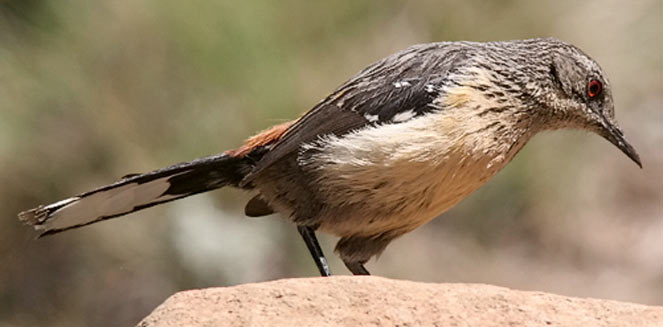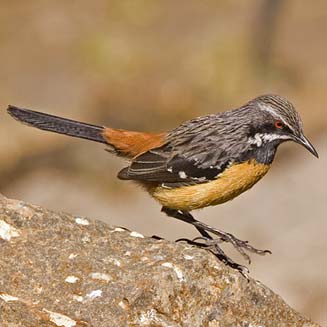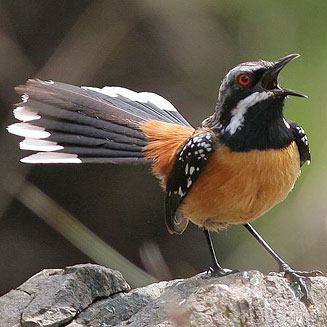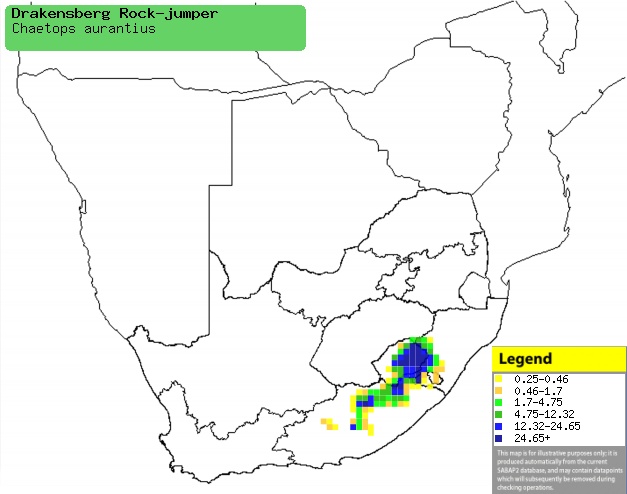|
Chaetops aurantius (Drakensberg
rock-jumper, Orange-breasted rock-jumper)
Oranjeborsberglyster [Afrikaans]; Molisa-lipela [South
Sotho]; Roodborst-rotsspringer [Dutch]; Chétopse doré [French]; Natal-felsenspringer
[German]; Saxícola-de-peito-alaranjado [Portuguese]
Life
> Eukaryotes >
Opisthokonta
> Metazoa (animals) >
Bilateria >
Deuterostomia > Chordata >
Craniata > Vertebrata (vertebrates) > Gnathostomata (jawed
vertebrates) > Teleostomi (teleost fish) > Osteichthyes (bony fish) > Class:
Sarcopterygii (lobe-finned
fish) > Stegocephalia (terrestrial
vertebrates) > Tetrapoda
(four-legged vertebrates) > Reptiliomorpha > Amniota >
Reptilia (reptiles) >
Romeriida > Diapsida > Archosauromorpha > Archosauria >
Dinosauria
(dinosaurs) > Saurischia > Theropoda (bipedal predatory dinosaurs) >
Coelurosauria > Maniraptora > Aves
(birds) >
Order: Passeriformes > Family: Chaetopidae
 |
|
Drakensberg rock-jumper female. [photo
Jeff Poklen
©] |
 |
 |
|
Drakensberg rock-jumper male, Sani Pass from South
Africa to Lesotho. [photo
Neil Gray
©] |
Drakensberg rock-jumper male, Sani Pass from South
Africa to Lesotho. [photo Trevor Hardaker ©] |
Distribution and habitat
Endemic to southern Africa, it is restricted to Lesotho's
highlands and the nearby montane grassland regions of the Eastern Cape,
KwaZulu-Natal and Free State Province. Its range does not overlap with the
Cape rockjumper's, but at one point the two
species separated by just 100-150 km. It is quite habitat specific, favouring
steep alpine grassland slopes with rocky outcrops.
|
 |
|
Distribution of Drakensberg rockjumper in southern Africa,
based on statistical smoothing of the records from first SA Bird Atlas
Project (©
Animal Demography unit, University of
Cape Town; smoothing by Birgit Erni and Francesca Little). Colours range
from dark blue (most common) through to yellow (least common).
See here for the latest distribution
from the SABAP2. |
Food
It exclusively eats insects, doing most of its foraging on
the ground, scratching and probing the soil surface in search of prey. The
following food items have been recorded in its diet:
Breeding
- It is a monogamous, facultative cooperative breeder, meaning that the
breeding pair are sometimes assisted by up to two helpers.
- Both sexes construct then nest, which is a large untidy cup built of
grass and twigs, lined with soft rootlets, grass and hair. It is usually
placed on the ground, well concealed by tufts of grass or an overhanging
rock, sometimes a small bush.
- Egg-laying season is from August-February, peaking from
October-November.
- It lays 2-3 white eggs, which are incubated by both sexes.
- The chicks are are fed by both sexes at regular intervals, their diet
consisting mostly of caterpillars and grasshoppers.
Threats
Not threatened.
References
-
Hockey PAR, Dean WRJ and Ryan PG 2005. Roberts
- Birds of southern Africa, VIIth ed. The Trustees of the John Voelcker
Bird Book Fund, Cape Town.
|
